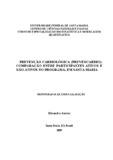| dc.contributor.advisor | Zanini, Roselaine Ruviaro | |
| dc.creator | Santos, Elisandra dos | |
| dc.date.accessioned | 2019-06-18T13:29:07Z | |
| dc.date.available | 2019-06-18T13:29:07Z | |
| dc.date.issued | 2009-08-10 | |
| dc.date.submitted | 2009 | |
| dc.identifier.uri | http://repositorio.ufsm.br/handle/1/17030 | |
| dc.description | Monografia (especialização) - Universidade Federal de Santa Maria, Centro de Ciências Naturais e Exatas, Curso de Especialização em Estatística e Modelagem Quantitativa, RS, 2009. | por |
| dc.description.abstract | The pattem anthropometric of the population and the food habits had alteration in last decades due to
the changes of style of life, because the frequence of the physical activities decreased and there were
changes in the habits food, thus a major incidence of cardiovascular’s disease. The aim this research
was study the effect of the preventive cardiologic program (PREVENCARDIO) achieved in Federal
University of Santa Maria, comparing the relative variables the active participants and no active in the
activities of the program. This research begun with 202 patients for the identification of the partipants
program profile, and after it was considered 108 participants, for the comparation In the profile’s
analysis we could see that the most variables anthropometric and biochemistry whether had kept
within of the limits considered of risk. The comparation between the first visit and the comeback for
the variables analysis in the active women and no active don’t showed significative difference,
However active women were with the best levels and kept it. Among the men also didn’t have
significative difference considering the first visit with the second one. The analysis of the odds ratio to
developed diseases cardiovasculares, considering the physical activities practice or no activities, these
patients don’t showed significative difference between the variables. The multiple linear regression
model adjusted for the difference of weight of the women between the first and second visit included
the variables: difference of the measure of the waist and the glucose and for the men were included in
the model in the variables: difference of waist-hip and of the total cholesterol. | eng |
| dc.language | por | por |
| dc.publisher | Universidade Federal de Santa Maria | por |
| dc.rights | Acesso Aberto | por |
| dc.rights | Attribution-NonCommercial-NoDerivatives 4.0 International | * |
| dc.rights.uri | http://creativecommons.org/licenses/by-nc-nd/4.0/ | * |
| dc.subject | Prevenção cardiológica | por |
| dc.subject | Atividades físicas | por |
| dc.subject | Qualidade de vida | por |
| dc.subject | Fatores de risco | por |
| dc.subject | Preventive cardiologic | eng |
| dc.subject | Physical activities | eng |
| dc.subject | Quality’s life | eng |
| dc.subject | Risk fatores | eng |
| dc.title | Prevenção cardiológica (Prevencardio): comparação entre participantes ativos e não ativos no programa, em Santa Maria | por |
| dc.title.alternative | Preventive cardiology (Prevencardio): comparasion betweem active and not active in the participants of program in Santa Maria | eng |
| dc.type | Trabalho de Conclusão de Curso de Especialização | por |
| dc.degree.local | Santa Maria, RS, Brasil | por |
| dc.degree.specialization | Estatística e Modelagem Quantitativa | por |
| dc.description.resumo | O padrão antropométrico e alimentar da população sofreram alterações nas últimas décadas
devido às mudanças no estilo de vida, diminuindo a frequência de atividade física e
modificando hábitos alimentares, ocasionando assim uma maior incidência de doenças
cardiovasculares. O objetivo deste estudo foi avaliar o efeito do programa de prevenção
cardiológica (PREVENCARDIO) realizado na Universidade Federal de Santa Maria,
comparando as variáveis relativas aos participantes ativos e aos não ativos nas atividades
previstas pelo programa. Realizou-se este estudo, inicialmente, com 202 pacientes para a
identificação do perfil dos participantes do programa, e posteriormente, para as comparações,
foram considerados 108 participantes. Na análise do perfil, notou-se que a maioria dos valores
das variáveis antropométricas e bioquímicas se mantiveram dentro das faixas consideradas de
risco. A comparação entre a primeira consulta e o retorno para as variáveis analisadas nas
mulheres ativas e não ativas não demonstrou diferença significativa, porém as ativas estavam
com os níveis melhores e assim se mantiveram. Entre os homens também não houve diferença
significativa, considerando-se uma consulta com a outra. Na análise da razão de chance de
desenvolver doenças cardiovasculares, levando em conta a prática ou não das atividades, estes
pacientes não apresentaram diferença significativa entre as variáveis. O modelo de regressão
linear múltipla ajustado para a diferença de peso das mulheres entre as duas consultas incluiu
as variáveis: diferença da medida da cintura e da glicemia e, para os homens, foram incluídas
no modelo as variáveis: diferença da relação cintura-quadril e de colesterol total. | por |
| dc.publisher.country | Brasil | por |
| dc.publisher.initials | UFSM | por |
| dc.subject.cnpq | CNPQ::CIENCIAS EXATAS E DA TERRA::PROBABILIDADE E ESTATISTICA | por |
| dc.publisher.unidade | Centro de Ciências Naturais e Exatas | por |



